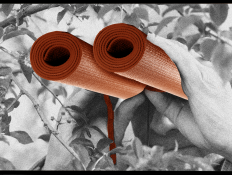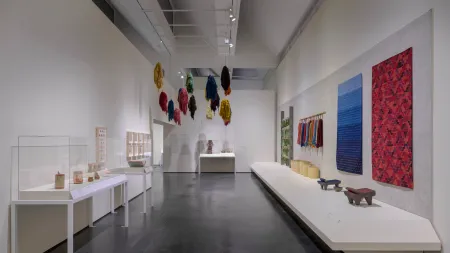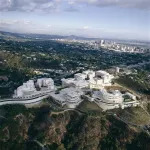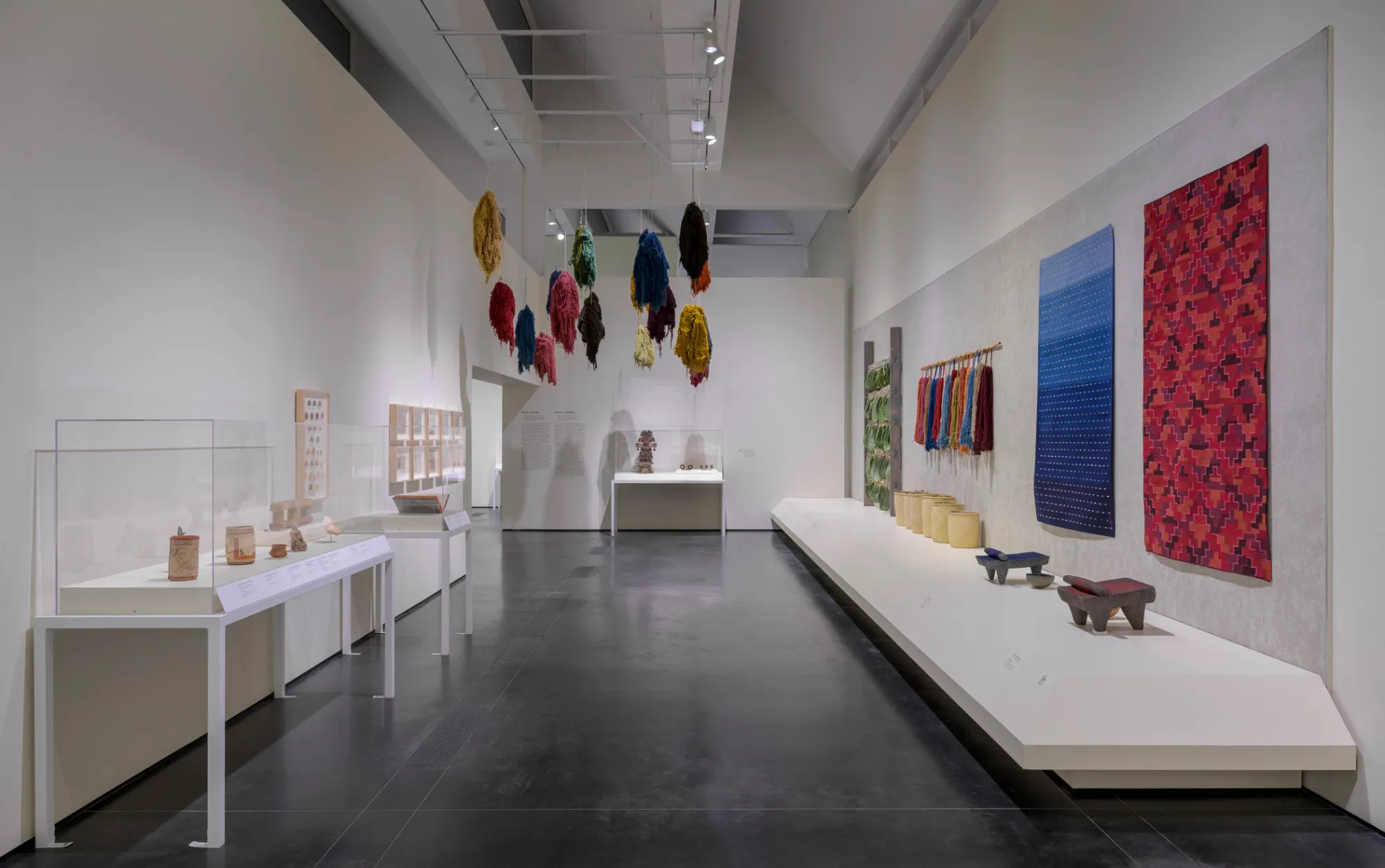
On first glance, one might be forgiven for wondering how the Los Angeles County Museum of Art’s new exhibition, “We Live in Painting: The Nature of Color in Mesoamerican Art,” fits into PST ART. For the 2024 edition of the recurring initiative, over 70 cultural institutions, supported by $20 million in grants from the Getty Foundation, will open shows based around the theme of “Art & Science Collide.” The LACMA exhibition, which opened Sunday, initially appears as a historical exhibition, featuring over 270 Mesoamerican ceramic vessels, mural fragments, stone sculptures, and textiles, over half of which are drawn from the museum’s permanent collection. There are also artworks and archaeological artifacts on loan from Mexico’s Instituto Nacional de Antropología e Historia and two rare, spectacular Mesoamerican codices from Oxford University’s Bodleian Library. A reasonable viewer might ask, where is the link to science?
At a press preview last week, California-based, Zapotec textile artist Porfirio Gutiérrez offered an answer. “Color comes from nature. Color is actually an extension of the information that each textile—in this case, the sculptures and the skeins of yarn—is a representation,” he said. “It is a database of the plants and where and when the plants were harvested.”
Threaded throughout the exhibition are commissioned works by Gutiérrez, as well as other contemporary Nahua, Tzotzil, Mixtec, and Zapotec artists, who have revived and reinterpreted Indigenous practices of pigment production, dyeing, weaving, and watercolor painting on amate bark paper. These works are the most entrancing of the exhibition, their colors deep and earthy. Two wool tapestries by Gutiérrez, one dyed darkening shades of blue and another turned crimson and black, demonstrate the richness of the pigments. Watercolor paintings by Eva Peréz Martínez, Jesús Lozano Paredes, Gisela Martínez Morales, Alfonso Nava Larios, and Rodolfo Rojas Bello, and an accompanying vitrine of swatches, show the breadth and variety that can be achieved through natural dye production, via materials like cochineal insects, marigold flowers, black walnut, and indigo. Linea del Tiempo, an installation of eighteen hanging wool skeins by Gutiérrez, each dyed a different shade, demonstrates the process. The colors, as he explained, are records of the climate, ecology, and location of materials harvested.
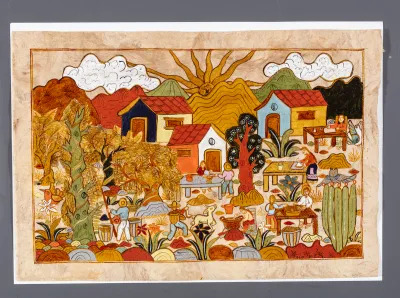
“In the Western world, the view of science is extremely narrow, and there hasn’t been an opportunity to expand on that vocabulary of what that means to these contexts,” he said. “Each work represents a time and a history. … It’s a database that archives this information so that we can go and look at one of these textiles and we know what happened 20 or 40 or 400 years ago through the colors.”
This contemporary representation of Indigenous practices is accompanied by a presentation of research by MOLAB, a European initiative analyzing the Mesoamerican codices—which are breathtakingly preserved artifacts in their own right—and the National Autonomous University of Mexico’s Prehispanic Mural Painting in Mexico Project, which analyzes Mesoamerica mural painting traditions.
“We Live in Color” is far from the only exhibition in this year’s edition of PST ART to either embed or center Indigenous knowledge in its conception of science and technology. At LACMA, there is also “Mapping the Infinite: Cosmologies Across Cultures,” opening October 20, which links Indigenous cosmologies and conceptions of time and cosmic structure, with that of European, Middle Eastern, and Asian cultures. (The Griffith Observatory is screening an accompanying film on the topic, Pacific Standard Time.)
At UCLA’s Fowler Museum, “Sangre de Nopal” focuses specifically on the Indigenous development and use of cochineal dye and also features work by Gutiérrez and fiber artist Tanya Aguiñiga. The Broad’s contribution to PST ART includes the public reforestation project Social Forest: Oaks of Tovaangar, in which 100 native trees will be planted in Los Angeles’ Elysian Park. Inspired by Joseph Beuys’s 1982 project 7000 Oaks for Documenta 7, the reforestation project is being done in partnership with nonprofit North East Trees, archaeologist Desiree Renee Martinez (Tongva), and artist Lazaro Arvizu, Jr. and is accompanied by educational programs that incorporate the knowledge and practices of the Tongva, one of Southern California’s Indigenous peoples.
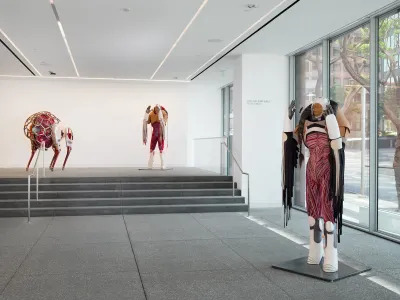
For “Breath(e): Toward Climate and Social Justice,” which opened Saturday, the Hammer Museum commissioned Indigenous artist Cannupa Hanska Luger to create Sovereign, a site-specific sculptural, video, and audio installation featuring three Indigenous space travelers wearing “sovereignty suits,” which nod to 1950s Hollywood science-fiction tropes. His travelers exist in a future realm where civilization has collapsed and humans have developed new modes of survival, care, and knowledge transfer. During a panel discussion for PST Art last week, Luger, a member of the Three Affiliated Tribes of Fort Berthold in North Dakota and of Mandan, Hidatsa, Arikara, Lakota, and European descent, explained that the work is based around his ongoing project Future Ancestral Technologies, which engages with possibilities for Indigenous futures, as well as the incorporation of ancestral knowledge today.
“As an Indigenous person, I am always trapped in this idea that our history and our cosmology is trapped in the past. Simultaneously, I’m watching green economies develop that seem to be co-opting Indigenous knowledge, and I’m like, ‘Can we acknowledge where that technology comes from, and then you’ll have 10,000 years of proof-of-concept versus five years of playing the game with investors?” he said. Later, Luger added that he hopes to “move Indigenous ideas, which are a technology, through the mechanisms of technology that we are developing today.”
Luger has also contributed one of the 58 works in the Autry Museum of the American West’s “Future Imaginaries: Indigenous Art, Fashion, and Technology,” which opened September 7. That exhibition centers on “Indigenous Futurisms,” a concept coined by scholar Grace Dillon (Anishinaabe) in 2012 to describe the growing movement in Indigenous arts and culture. Curators Amy Scott, Amber Dawn Bear Robe (Siksika), Kristen Dorsey (Chickasaw), and Suzanne Newman Fricke divide the exhibition into three sections: fashion, science fiction, and “Critical Mass: Indigenous Technologies, Ecologies, and the Future.”
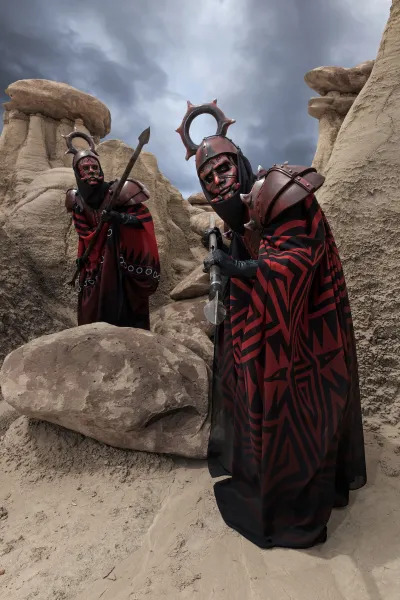
Similar to the curatorial approach to an expanded notion of science in “We Live in Painting,” the final section of “Indigenous Futurisms” broadens the understanding of “technology” to incorporate Indigenous knowledge systems. In Suzanne Kite (Oglála Lakȟóta) and Devin Ronneberg’s interactive sculpture ÍŊYAŊ IYÉ (TELLING ROCK), visitors are encouraged to move the hanging sculpture’s long braids; a custom AI shifts how it emits light and sound in response to how the braids are touched. As the title indicates, the work speaks to the Lakota cosmological conception that inanimate objects have souls and communicate, and therefore should be handled respectfully. It’s easy to see how that simple idea has dramatic implications for how one treats and understands the world and our environment. (Kite recently talked to ARTnewsabout the importance of embedding Indigenous design into AI.)
As Newman Fricke explained in a curator roundtable published in the Future Imaginaries catalog, there is an ongoing Indigenous effort to redefine “technology” beyond computers, phones, and circuit boards.
“Technology is any process that has been refined,” she says, adding that in a conversation with Pueblo artist Virgil Ortiz, who contributed a site-specific installation to the exhibition, they talked about how artists’ understanding of materials is a technology.
That idea is no more apparent than in “We Live in Painting,” where Indigenous artists and scientific researchers are still trying to figure out how to reproduce the pigments recorded in the Mesoamerican codices on display. Future Ancestral Technologies, indeed.
Getty Museum Returns Funerary Artifact to Turkey
Helen Pashgian, a Pioneer of California’s Light and Space Movement, Continues to Produce Work that Astounds

Nicole Scherzinger’s $7 Million Home Has Sweeping Views From Downtown L.A. to the Pacific

Melania Trump’s Modeling Days Revealed by Photographers
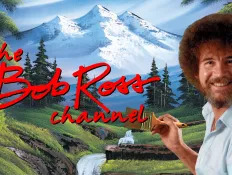
Google TV Freeplay just added 7 new live TV channels, including Bob Ross

Relevent to Manage Bundesliga Media Rights in the Americas
